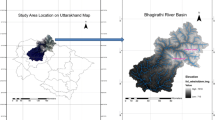Summary
The mean monthly and annual rainfall series (1930–1977) for 30×30 blocks in the eastern Transvaal-Swaziland region ara analyzed. These series show temporal and spatial characteristics in the regional precipitation regime. Significance is attributed to oscillatory forcings with quasi-periodicities of about 16–20 years and 13–14 months that operate throughout the area. Oscillations near the quasi-biennial cycle are also observed but with less significance.
Principal component analysis provides a number of eigenvectors which are identified with changes in the seasonal characteristics of the regional rainfall. The annual cycle clearly dominates over the entire region with January (mid-summer) being the wettest month. The second eigenvector has pronounced loadings in the spring/early summer (November) period and clear spatial responses that are attributed to topographically induced differences in the deep convective processes of the area. Higher principal components are not as clearly defined in their temporal structure. The third eigenvector, however, is attributed partially to synoptic scale forcings which produce different rainfall characteristics over the coastal plains relative to the high inland plateau.
Zusammenfassung
Die mittleren monatlichen und jährlichen Regenfallsreihen (1930–1977) für ein 30×30 Bogenminuten-Netz im östlichen Transvaal und Swaziland wurden analysiert. Diese Reihen zeigen eine charakteristische zeitliche und räumliche Veränderlichkeit des Niederschlagsregimes, deren Signifikanz auf quasi-periodische Anregung mit Perioden von ungefähr 16–20 Jahren und 13–14 Monaten, im gesamten Gebiet evident, zurückgeführt werden kann. Schwingungen im Bereich eines quasi-biennalen Zykluses wurden ebenfalls beobachtet, jedoch mit geringerer Signifikanz.
Eine Analyse der Hauptkomponenten ergibt eine Anzahl von Eigenvektoren, welche mit den Änderungen im jahreszeitlichen Charakter des regionalen Niederschlages identifiziert werden können. Der Jahresgang dominiert eindeutig in der gesamten Region, wobei Januar (Mittsommer) der nasseste Monat ist. Der zweite Eigenvektor besitzt hohe Amplituden im Frühling und Frühsommer (November) und zeigt eine räumliche Verteilung, die auf topographisch induzierte Unterschiede in den Konvektionsprozessen dieses Gebietes zurückzuführen ist. Die Hauptkomponenten höherer Ordnung sind in ihrer zeitlichen Struktur nicht eindeutig definiert. Der dritte Eigenvektor kann jedoch zum Teil auf synoptische Vorgänge bezogen werden, welche in den Küstenebenen und im Plateau des Hinterlandes verschiedene Niederschlagsvertefungen bewirken.
Similar content being viewed by others
References
Brier, G. W.: Long Range Prediction of the Zonal Westerlies and Some Problems in Data Analysis. Rev. Geoph.6, 525–551 (1968).
Brief, G. V., Meltesen, C. T.: Eigenvector Analysis for Prediction of Time Series. J. Appl. Met.15, 1307–1312 (1976).
Brief, G. W., Kelbe, B. E.: Statistical Prediction of Complex Phenomena Using a One Parameter Multiplicative Model (OPMM). WMO Symposium on Probablistic and Statistical Methods in Weather Forecasting, Nice, France (1980).
Carte, A. E., Held, C.: Variability of Hailstorms on the South African Plateau. J. Appl. Met.17, 366–373 (1978).
Craddock, J. M., Flood, C. R.: Eigenvectors for Representing the 500 mb Geopotential Surface Over the Northern Hemisphere. Quart. J. R. Met. Soc.95, 576–593 (1969).
Dyer, T. G. J.: The Assignment of Rainfall Stations into Homogenous Groups: an Application of Principal Component Analysis. Quart. J. R. Met. Soc.101, 1005–1012 (1975).
Dyer, T. G. J.: On the Components of Time Series: the Removal of Spatial Dependence. Quart. J. R. Met. Soc.102, 157–165 (1976).
Dyer, T. G. J.: Meridional Interactions Between Rainfall and Surface Pressure. Nature264, 48–49 (1976).
Dyer, T. G. J.: Rainfall Along the East Coast of Southern Africa, the Southern Oscillation and the Latitude of the Subtropical High Pressure Belt. Quart. J. R. Met. Soc.105, 445–451 (1979).
Fisher, R. A.: Test of Significance in Harmonic Analysis. Contr. Math. Statis. New York: Wiley 1950.
Fisher, R. A.: On the Similarity of the Distributions Found for the Test of Significance in Harmonic Analysis and Steven's Problem in Geometrical Probability. Contr. Math. Statis. New York: Wiley 1950.
Kelbe, B. E.: Factors Contributing to the Development of Convection Over Northeastern South Africa and Swaziland. Ph.D. Dissertation, 261 pp. University of Virginia, Charlottesville (1982).
Lorenz, E. N.: Empirical Orthogonal Functions and Statistical Weather Predictions. Sci. Report No. 1, Contract AF19(604)-1566, Dept. of Meteorology, Mass. Inst. Tech., Boston, Mass. (1956).
Mather, G. K.: An Analysis of a Possible Crop Response to Hail Suppression Seeding: the Nelspruit Hail Suppression Project. J. Appl. Met.16, 959–970 (1977).
Nicholson, S. E.: The Historical Climatology of Africa. In: Climate and History (Wigley, T. M. L., Ingram, M. J., Farmer, G., eds.), pp. 249–270. Cambridge University Press 1981.
Nicholson, S. E.: Rainfall and Atmospheric Circulation During Drought Periods and Wetter Years in West Africa. Mon. Weath. Rev.109, 2191–2208 (1981).
Pankofsky, H. A., Brier, G. W.: Some Applications of Statistics to Meteorology, 224 pp. University Park, Penn.: State Univ. Press 1968.
Sellers, W. D.: Climatology of Monthly Precipitation Patterns in the Western United States, 1931–1966. Mon. Weath. Rev.96, 585–595 (1968).
Tyson, P. D.: Atmospheric Circulation Changes and the Occurrence of Extended Wet and Dry Spells Over Southern Africa. I.G.U. Working Group on Desertification in and Around Arid Lands, Fujinomiya, Japan 1980.
Tyson, P. D., Dyer, T. G. J., Mametse, M. N.: Secular Changes in South African Rainfall, 1880–1972. Quart. J. R. Met. Soc.101, 817–833 (1975).
Author information
Authors and Affiliations
Additional information
With 13 Figures
Rights and permissions
About this article
Cite this article
Kelbe, B.E., Garstang, M. & Brier, G. Analysis of rainfall variability in the northeastern region of South Africa. Arch. Met. Geoph. Biocl., Ser. B 32, 231–252 (1983). https://doi.org/10.1007/BF02273976
Received:
Issue Date:
DOI: https://doi.org/10.1007/BF02273976




